Charlie Smyth, a long-time member of the Urbana City Council, joined me at Cafe Paradiso to chat as part of our ongoing series on local politicians. Through the course of our conversation I learned that he’s a passionate biker and that he has a lot to say about how Urbana may change in the coming years.

Question 1.
Smile Politely: How did you first come to Urbana?
Charlie Smyth: I came as a graduate student in 1979 and never left, though I tried at one point… I went to another graduate school and decided that wasn’t for me, so ended up coming back here. Then I started working at the university, where I worked for 30+ years, met my wife, and raised a couple kids here.
Question 2.
SP: How did you become involved with city council?
Smyth: It’s all Mike Weissman’s fault. I was originally on the city council from 1989-1993. In November or December of 1988, he was helping to look for a candidate to run for city council. My home was in Ward 2, which at the time was a large rectangle of businesses near campus plus a two block residential area. Mike and I happened to live in that two-block area. Mike knew that I was very opinionated, and he made me put my money where my mouth was. And part of me has always wanted to be involved and give back. I ran for school board when I was 19. I had wanted to be involved in my community for a long time.
Originally, I only did one term and then went to coaching soccer, which my sons were involved in, for the next 10 years. When I blew out my knee and retired from coaching soccer, I went back to city council. I succeeded my successor, essentially. When she decided she’d had enough, she convinced me to run again. I recently joked with her that it’s been about 12 years since I rejoined city council, so now it’s her turn to take over again.
Question 3.
SP: What is your professional background?
Smyth: I was trained as a bio-statistician, but during my time at the university I moved into programming and applied statistics then to general IT. I ended as an IT manager. I’m currently retired, but I do a little private IT stuff on the side for friends.
And my big hobby is bicycling. I took my training wheels off my own bike when I was a little kid. I did have a car my senior year in high school, but I got back into bicycling in college. When I moved here, I lived close to campus and biked everywhere. I prided myself on being able to beat the buses back and forth.
My wife and I met through cycling. Our first date was a 65-mile bike ride, here locally, through the Prairie Cycle Club.
Question 4.
SP: During your time on city council, what projects have most captured your attention?
Smyth: The big one that sticks out from my first term, from 1989-1993, is the re-zonings we did. We created the mixed office residential area along Green Street and “down zoned” the area between Vine and Race along Broadway. At the time, that area was full of high-density apartments. There was a lot of pressure in the neighborhoods about inappropriate developments occurring alongside residential housing because the University was pushing everything out between Wright Street and Lincoln.
We came up with a re-zoning plan that put up a bit of a buffer. It’s not perfect, but the idea was to have residential backyards facing one another. We were able to do a lot of very careful zoning, such as lower zoning on one side and higher on the other side. I’m very proud of that.
Roughly 25 years later, the neighborhood seems a lot more stable. We still have houses that have been converted to apartments, and in some cases they’re not very well taken care of, but at least now we have a defined transition between Urbana and the University, and the University is not encroaching further.
And in the meantime, we’ve tightened up maintenance codes. Homes and apartment buildings are expected to meet high inspection standards.
Question 5.
SP: What projects have you been working on more recently on council?
Smyth: In 2005, along with Laurel Prussing, I suggested that we create city goals for Urbana. We developed 13 goals and eventually added another. The goals were broken down into tasks and objectives within each goal to be accomplished during our four-year term.
We organized the goals into three tiers in terms of importance, and we’re currently in the third tier of goals. Having those goals has changed the way that council operates. We get proposals for all kinds of goals, but each goal has to have majority support. That means that we don’t just bless whatever staff brings before us. We think that as publically elected officials, we should work on the things that the public wants us to work on.
These goals have been updated every term since then: in 2005, 2009, and 2013. We’re currently working on the 2013 goals.
Question 6.
SP: What kinds of topics do these goals cover?
Smyth: One of our goals is to become a more multi-modal community, which would allow us to become “micro-urban.” There are other areas, such as public safety and financial sustainability. And another big part of the goals is rethinking mixed business and residential zoning so we can expand the downtown area. A true urban community has business and residential zoning mixed—that’s an urban concept. We can do that in a small city, with the same benefits but without the congestion. So the goals allow us to have a big vision for downtown.
Question 7.
SP: Has there ever been a time you felt your constituents were against that you decided you had to vote for, or vice versa?
Smyth: That’s something I find so nice about where I’m living right now. I don’t really have to compromise about my own values to represent the vast majority of my ward. It’s been a real pleasure to articulate my own position and get positive feedback. It hasn’t been 100% by any means, but I don’t think I’m so far out there in comparison to my constituents. Two of my precincts voted majority Green in the 2010 election, so if anything I suspect I’m not progressive enough for some of my constituents.
But I did insist we go to four-way stops at Oregon and Cohler, which wasn’t really popular. We had already set in a precedent of putting stop signs to slow traffic down in other areas. Four-way stops aren’t all great, but in hindsight they have worked out well at Oregon and Cohler and in other places.
Though there are other methods of slowing traffic, such as traffic circles, which don’t reduce momentum as much. Traffic circles are a topic where I may be pushing something that the majority may not support. I would do a roundabout in a minute if I could. But people are very reticent to try that in this community. Illinois is 49th out of 50 states in terms of roundabouts: Indiana, Wisconsin, Minnesota are all using modern roundabouts more frequently than we are. I think if you can’t have a modern roundabout, the next safest thing is a four-way stop.
Question 8.
SP: How would you characterize Urbana’s relationship to its sister city, Champaign?
Smyth: They’re different, and we need to make them different. We can’t all be doing the same thing. There are common things people want in a micro-urban environment: places to eat, shopping, places to go to work, and places to buy groceries. Having places like Strawberry Fields and Common Grounds available makes Urbana a bit different than Champaign.
The other thing that’s very different between the two cities is that Urbana is the county seat. When you have the two courthouses, you have a different kind of downtown—you have lawyers all over the place.
Champaign of course has the wonderful Campustown area. The geography of Wright Street puts a gold mine in the city of Champaign. The income that students bring to Champaign by having Campustown, that 6×2 block area, has a huge impact. And the Champaign downtown has been a center of nightlife for a long time.
Urbana is a good place where you can try out a small business. I think the costs of rent are bit lower here, and in that way I think Urbana is trying to cater to small businesses.
 Question 9.
Question 9.
SP: What do you see as the most pressing concern for your ward in the upcoming year?
Smyth: The issue of neighborhood preservation is continuous. There’s always pressure from the university and from people who want to buy property to rent it out. For instance, we’ve had a lot people who buy a property for their kid while they’re here going to school and then rent it out once they graduate. We’ve addressed that in a few ways, but still two-thirds of our residential units in this community are rentals. So neighborhood preservation means keeping rentals at the same level of quality as owner-occupied homes.
Another long-term goal issue would be how to integrate the increasing population of this city with the community itself.
Question 10.
SP: How do you think Urbana might change in response to increasing population?
Smyth: We need to think about taking our current communities and keeping them multi-modal in terms of bike and pedestrian access with the pressure of increasing population. I think that involves developing a multi-use downtown. We have space to develop vertically, and I think we should.
We don’t have a great connection between downtown Urbana and the university. But we have a lot of graduate students and young professionals who work at the university, so we should develop that.
What people don’t understand is that owning a car is about a $10,000 hit on your annual budget. So if a family can own a bike or walk instead, that can save a family a lot of money.
Question 11.
SP: When we corresponded to set up this interview, you mentioned you are involved in some upcoming bike-related events. Can you describe those?
Smyth: There’s a whole collection of them. First, we have the Illinois Bike Summit on April 15th. It’s an event that started three years ago in Bloomington/Normal. A city planner from that area reached out to us about starting this event, and we’re happy to be hosting it here this year.
I’m also very involved in Champaign County Bikes, which has been around since 2006. We did our first bike map in 2008, which we based on a map from an earlier group in the 1970s. Bike advocacy is not a new thing in this community! We do Bike Month every year. Through that program, we’ve developed Bike to Market Saturdays. The market has expanded bike parking in the past few years, and we probably need to do that again. We have a number of events during Bike Month: Bike to Work Day, Bike to School Day, and Bike to Campus Day. We’re also having a bike expo indoors at Lincoln Square on May 3rd.
Question 12.
SP: Who are your political heroes?
Smyth: It’s always very hard for me to pick one person or one thing because I’ve been exposed to so much. I was very influenced by a progressive talk radio show in NYC when I was in 9th grade. It would come on late at night, and it would result in me not getting to sleep on time. It caused me to do things like read biographies of Gandhi. My father was career military; while he was in Vietnam, I was an anti-war protester, which created some conflict. So Gandhi is a big political hero for me.

Question 13.
SP: How would you characterize your political philosophy?
Smyth: Progressive practical. If you can’t envision it, you can’t do it. I really believe in setting some challenging goals that are practical and things you can get done in a 5-year time frame. If they continue on past that, great, but they should still lead to some nice yearly benefits. And I also believe in long-term goals. I think you have to be able to take risks. I believe you can’t do something in between.
Question 14.
SP: What is your long-term vision for Urbana?
Smyth: One big piece for me would be bicycle infrastructure. There are still nine big intersections that are difficult to cross in Urbana. We’d like to get rid of all of them. We have to fix the connectivity issues in Urbana to become a more bicycle and pedestrian friendly community.
We also need to finish the Boneyard Creek project. That’s my longest-term vision. I’d like to see a micro-urban corridor developed along the Boneyard area and connecting to campus.
Question 15.
SP: What spaces in Urbana do you really enjoy?
Smyth: We’re sitting in one of them [Café Paradiso]. I enjoy Flying Machine coffee. I’m a regular at all of the restaurants in Urbana. Courier Café is a place we used to go with our kids when they were little; now we love going to Black Dog because my younger son is a big barbeque fan. And the other is a big fan of Indian food, so Sitara has been a wonderful addition to downtown.








